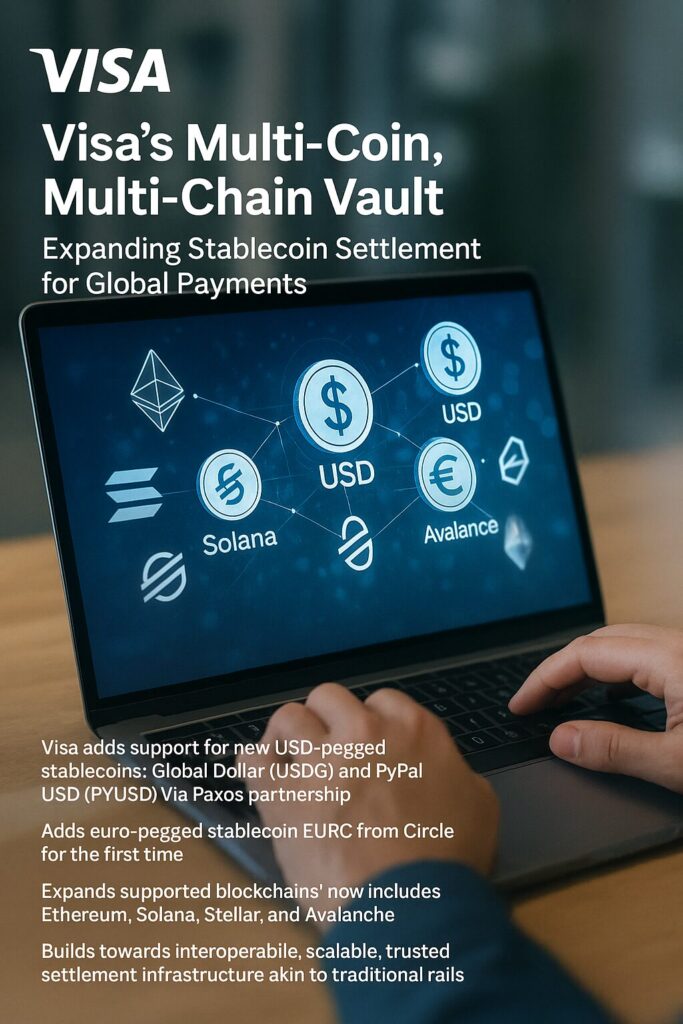
Main Points:
- Visa adds support for new USD‑pegged stablecoins: Global Dollar (USDG) and PayPal USD (PYUSD) via Paxos partnership.
- Adds euro‑pegged stablecoin EURC from Circle for the first time.
- Expands supported blockchains: now includes Ethereum, Solana, Stellar, and Avalanche.
- Builds towards interoperable, scalable, trusted settlement infrastructure akin to traditional rails.
- Aims to serve issuers, acquirers, fintechs, and banks with fast, cross-border, multi-currency payments.
- Reinforced by ongoing pilots and growing institutional stablecoin interest.
Introduction
Visa’s recent announcement marks a strategic leap in its settlement infrastructure, embracing more stablecoins and blockchain ecosystems to enrich global payment capabilities. Tailored for readers exploring emerging crypto assets or blockchain use in real-world payments, this article unpacks the expansion’s significance, adds updated context, and reflects on what it means for revenue and cross-border settlement evolution.
Expansion of Stablecoin Support
Visa’s settlement platform now supports four stablecoins across different currencies:
- USD-pegged: USDC (already supported), Global Dollar (USDG), and PayPal USD (PYUSD)—both integrated via a partnership with Paxos.
- EUR-pegged: Circle’s EURC, marking Visa’s first euro-backed stablecoin settlement offering.
This gives Visa’s partners flexibility in choosing between dollar and euro instruments for on‑chain settlements.
Multi-Chain Settlement Infrastructure
Originally operated on Ethereum and Solana, Visa’s platform now also supports Stellar and Avalanche, providing:
- Greater interoperability across blockchain ecosystems.
- More options for partners to choose the most efficient chain.
This diversification enhances speed, reliability, and choice in settlement rails.
Strategic Vision: Interoperable, Scalable, Trusted Infrastructure
Visa’s leadership underscores a grand mission:
“Visa is building a multi‑coin and multi‑chain foundation to help meet the needs of our partners worldwide… when stablecoins are trusted, scalable, and interoperable, they can fundamentally transform how money moves around the world.”
– Rubail Birwadker, Visa
This echoes a broader goal: enabling seamless, blockchain-native cross-border payments rivalling traditional systems in security and global reach.
Real-World Adoption and Pilot Programs
Visa builds upon years of pilot programs:
- USDC settlement pilots began in 2021 via Ethereum and Solana.
- USDG Network includes partners like Robinhood, Kraken, Galaxy Digital, particularly in regulated environments like Singapore.
- Visa offers stablecoin‑linked cards in Latin America through a partnership with Bridge (Stripe-owned), allowing everyday purchases using stablecoins—with plans to expand globally.
Market Trends and Institutional Momentum
While stablecoin transaction volume reached around $48.5 billion in the past year, true merchant usage remains a small slice—mostly focused on B2B and cross-border use cases.
At the same time, the stablecoin market cap has surged beyond $273 billion, with projections heading toward the trillion-dollar range.
BlackRock recently identified stablecoins as one of five “mega forces” in investment, emphasizing their role as programmable digital cash for payments and DeFi.
Visa’s expansion thus positions it at the confluence of blockchain innovation and mainstream financial infrastructure transformation.
Summary Table
| Component | Visa’s Expansion | Significance |
|---|---|---|
| Stablecoins | USDC, USDG, PYUSD, EURC | Multi-currency settlement capabilities across networks |
| Blockchains | Ethereum, Solana, Stellar, Avalanche | Increased interoperability and settlement flexibility |
| Partnerships | Paxos (USDG, PYUSD), Circle (EURC), Bridge (cards) | Broader access via regulated and fintech channels |
| Market Context | ~$273B market cap, growing institutional interest | Long-term infrastructure underpinning digital payments |
Conclusion
Visa’s expansion of stablecoin and blockchain support is more than a feature update—it’s a strategic repositioning at the intersection of fintech innovation and global payment infrastructure. By enabling multi-currency, blockchain-agnostic settlements, and integrating partners from both crypto and traditional finance, Visa stands to redefine global merchant settlement and treasury operations. For those exploring new crypto assets or blockchain applications in payment systems, this represents both a signal and a roadmap: traditional rails are evolving, and opportunities are opening for innovation and growth in real-world, enterprise-grade blockchain use.

